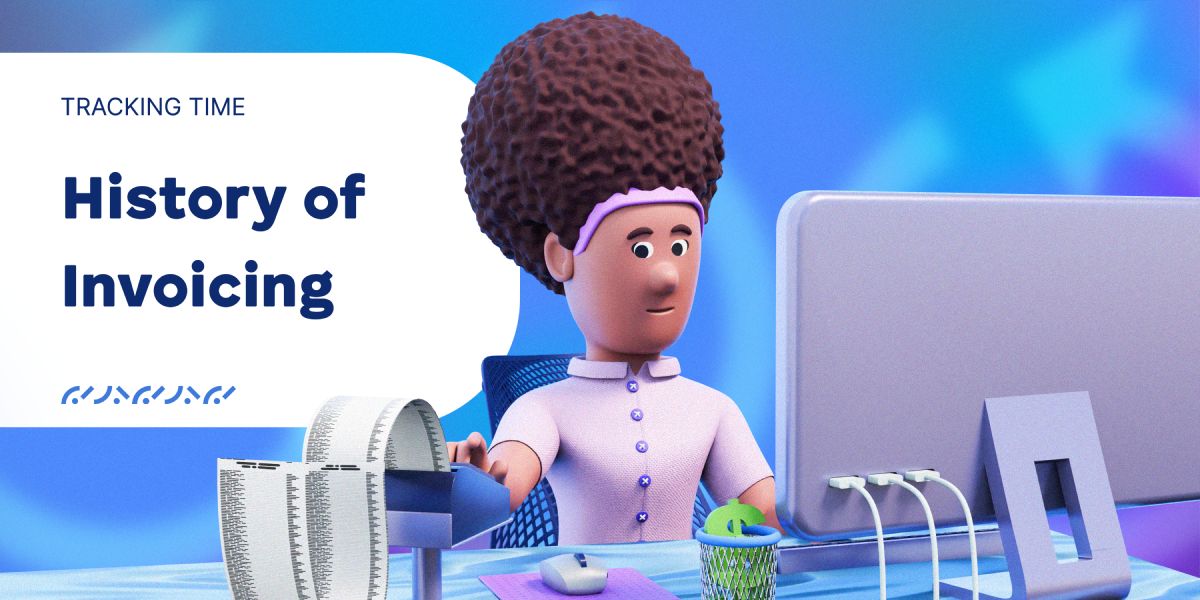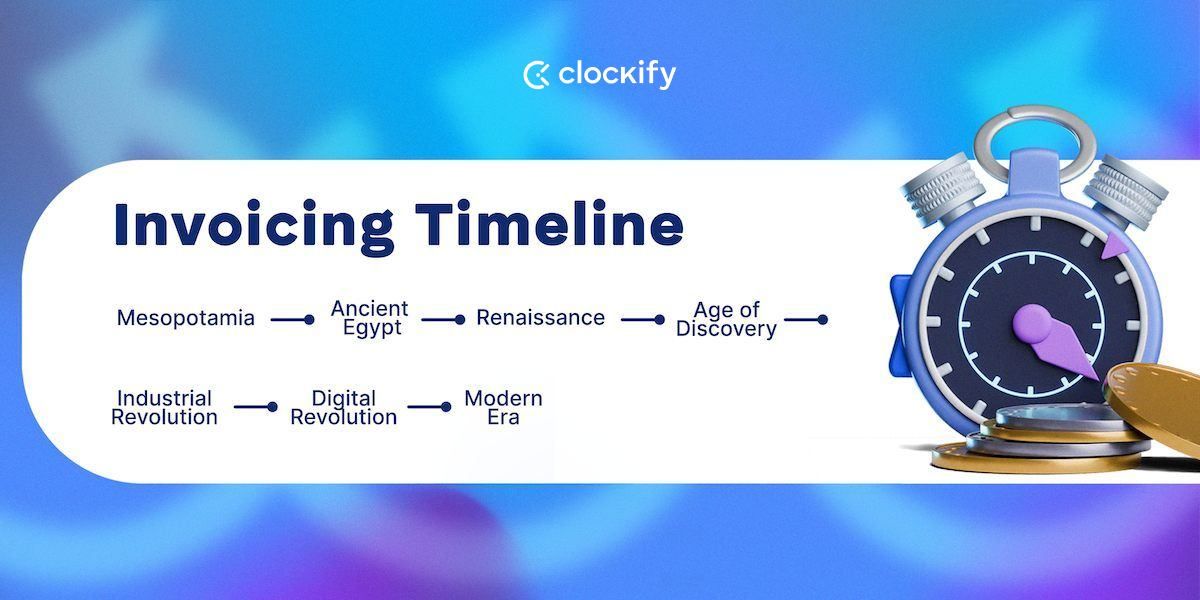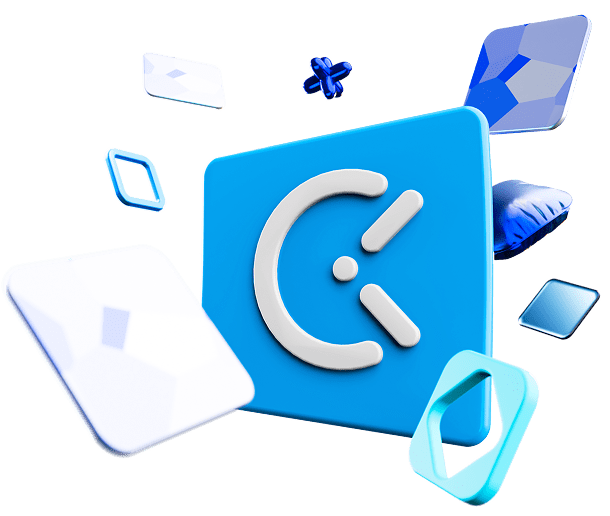Did you know that the concept of invoicing is about 5000 years old?
From the simplest marketplace barters to complex digital systems, we have come a long way in refining the process of tracking work hours for precision in client invoicing.
This story isn’t just for history buffs or tech enthusiasts but for anyone curious about how everyday processes impact our work and economic exchanges.
Let’s explore together how the past shapes our present and guides our future decisions in the world of commerce.

Table of Contents
3000 BC: Sumerian clay tablets in Mesopotamia
Long before the concept of money as we know it today, there was trade — the lifeblood of ancient civilizations. In these ancient markets, transactions were straightforward, but required diligent recording to ensure fairness and accountability.
Merchants in Mesopotamia are considered to be among the first to record transactions. These were highly skilled individuals who mastered the art of cuneiform writing on clay tablets. In fact, the very first invoices recorded on clay tablets date back to 3000 BC!
These tablets weren’t just for epic tales like that of Gilgamesh — they were the ledgers of their time with meticulous details on:
- Transactions,
- Quantities,
- Items, and
- Terms of trade agreements.
So, as a novelty at the time, clay tablets also made way for a more permanent method for recording transactions.
1200 BC: New scripts improve the invoicing process
With the advancement of civilizations, new record-keeping methods emerged as well. The Egyptians used papyrus, contributing to the sophistication of commercial documentation.
The Phoenicians, renowned for their alphabetic script, contributed further to the evolution of invoicing, making the process more accessible.
Interestingly, the Library of Alexandria also contained scrolls and records of trade transactions that might have influenced the economic policies of entire empires.
Thus, the story of invoicing is woven intricately into the story of civilization itself. This brings us to the next stage of the invoicing journey — the ledger.

15th century: The ledger comes to light
Fast-forward to the very heart of 15th-century Venice, where a commercial revolution of the early Renaissance took place. A Franciscan friar, Luca Pacioli, would pen the Summa de arithmetica, introducing double-entry bookkeeping to the Western world.
This method provided merchants with a systematic way to track their debits and credits. The ledger, a bound book with pages lined for entries, became the cornerstone of business documentation.
During the Age of Discovery, European ships sailed to new worlds, and ledger books grew thick with entries for goods and treasures.
Silver from the New World, spices from the East, and silks from China filled the coffers and pages of European merchants’ books. Invoicing and bookkeeping became key factors that would decide the success of the voyage itself.
18–19th centuries: The printing marvel
The new chapter of the invoicing story started with The Industrial Revolution. Steam power, the spinning jenny, and the power loom — these innovations transformed industries, and with them, the scale and speed of invoicing needed to adapt.
The typewriter, a marvel of mechanical engineering, entered the office in the late 19th century. It allowed invoices to be produced faster and with clarity that hand-written entries couldn’t match.
Carbon paper enabled the simultaneous creation of duplicates, an innovation that mirrored the era’s emphasis on efficiency and reproduction.
This, however, was still the early stage of invoicing as we know it today.
Stepping away from physical documents and paper, the digital age would create a global change. That said, you might find the following to be more familiar: the computer.
Mid–20th century: Invoicing moves to the computer age
In the 1950s and ‘60s, the shift that would redefine whole nations and the very fabric of commerce happened — the Digital Revolution. The transformation that was set in motion would move the old invoicing practice to the realm of bits and bytes.
At the time, the world’s first computers were like behemoths, taking up the space of entire rooms.
These machines may indeed have been primitive compared to what we have today. Still, the early adopters in the business world recognized the potential of computers for simplifying processes in the future. This started the natural shift toward digital invoicing.
1970–80s: The birth of digital invoice
In the 1970s and ’80s, personal computers became more accessible to both large corporations and small businesses.
Software developers seized this opportunity, creating the first dedicated invoicing programs. These programs could automate entire processes — from generating data-based invoices to managing accounts.
And so, the digital invoice was born! Physical documents were a thing of the past. The digital file could be sent across the globe in seconds via the emerging internet.
Naturally, new specialized software slowly emerged, but more on that in a bit.
💡 Clockify Pro Tip
Track your billable hours, create invoices, and analyze client profitability with our completely free project time tracker:
Late 20th and early 21st century: Specialized software for business management
The rise of ERP (Enterprise Resource Planning) systems marked the beginning of this new era at the turn of the 21st century. These systems could integrate various operational aspects of a company into a single, unified digital platform.
Invoicing became a part of a larger ecosystem, allowing for a smooth connection with:
- Supply chain management,
- Human resources, and
- Customer relationships.
This integration was a true game-changer! You could now access real-time financial health insights and employ more strategic decision-making.
The evolution didn’t stop with large corporations. Small to medium-sized enterprises (SMEs) started utilizing invoicing and billing software. Thanks to these tools, even the smaller players could enter the global commercial competition and efficiently manage their finances.
Customer Relationship Management (CRM) software entered the scene in the late 1990s and early 2000s. These systems started integrating invoicing features, enhancing customer interactions and ensuring timely payments.
New options and functionalities meant that you could do business with more ease and security than ever before. This upgrade was also a strategic move that improved customer satisfaction and loyalty.
As the internet became essential in business practices, cloud-based platforms emerged. This innovation offered businesses mobility and flexibility.
It was now possible to:
- Manage invoices,
- Track payments, and
- Check financial health from anywhere in the world, with just a tablet or a smartphone!
You, too, probably enjoy the benefits of software integration and automation for various personal and professional purposes. So, let’s continue with the modern era.
2019 onward: Automations and time tracking
Today, automation in invoicing isn’t just a luxury but a necessity. The modern marketplace operates at a speed that merchants from Mesopotamia, ancient Egypt, or 15th-century Venice could barely imagine.
Automation turned the time-consuming task of invoicing into an error-free process — all without a single paper changing hands! Software systems now have the capability to:
- Track payments,
- Generate invoices automatically, and
- Send those invoices to clients.
Some software systems offer time tracking and base invoices created on the time spent working.
Enter Clockify.
Clockify allows you to track work hours down to the minute, ensuring that every billable hour is included in your invoices.

You can manually add items, apply discounts, and adjust taxes to tailor each invoice to specific needs. This flexibility extends to managing the invoices, too, as you can track the status of each — whether they’re paid, partially paid, or overdue — directly within the app.
From the clay tablets of ancient Mesopotamia to the sophisticated digital interfaces of Clockify, the journey of invoicing through the ages is a remarkable story of innovation and technological advancement.
After 5000 years, we have arrived at the point of using tools like Clockify for invoicing and time tracking. And the journey continues.



